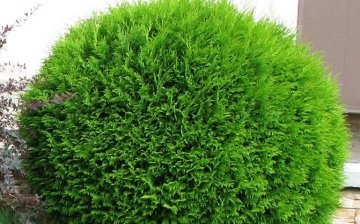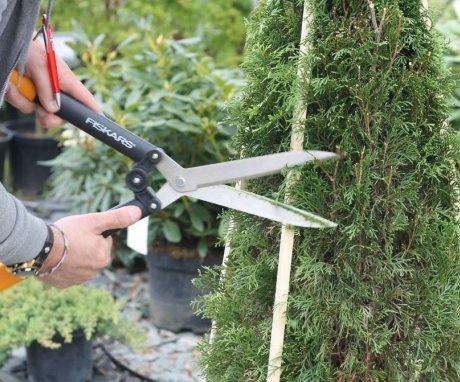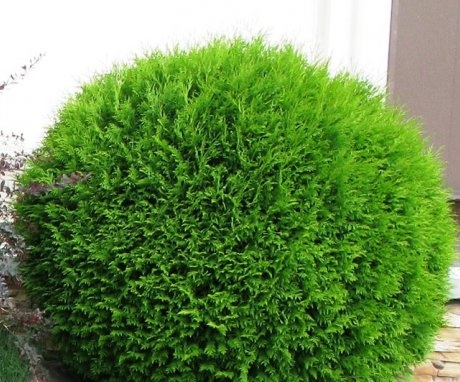Basic rules for pruning thuja in the fall and a step-by-step guide for beginners
Thuja has won the love and recognition of gardeners around the world and has become one of the most common elements of landscape design due to its aesthetic decorativeness, ability to obediently form a crown and grow relatively quickly.
By trimming, the thuja can be unusually fit into the most ordinary and inconspicuous garden.
Why cut thuja in the fall
Autumn is the time of sanitary pruning, at this time dry and damaged shoots, dead branches that interfere with the growth of the crown, should be removed. These manipulations should be done in dry, not windy weather, using a garden pruner, scissors or a saw as tools, depending on the size and thickness of the shoots.
It should be understood that sanitary measures for pruning thuja in the fall should not diverge from the general plan for the formation of the crown: that is, when removing certain branches, watch how this will affect the further growth and development of thuja, so as not to accidentally cut off the shoots needed in the formation of the crown.
In the autumn period, in the absence of the need for sanitary measures, corrective pruning is also carried out, aimed at securing the final result of the forming pruning carried out during the ended active vegetative period.
Is it necessary to carry out autumn pruning
Sanitary pruning is carried out as necessary, only with those trees that have damaged branches and shoots or a thickened crown. Whole healthy plants do not need such an event for sanitary purposes. However, it is quite possible to trim the crown in order to create a certain style of the crown in the fall, using the correct algorithm described below.
Advantages and disadvantages of autumn pruning
When planning pruning thuja in the fall, it is worth considering the following nuances:
- shoots must not be cut off before the onset of cold weather, since the cuts on the shoots will not have time to heal and may begin to become stained, turn yellow and die off, due to infection with fungal diseases;
- choose a relatively warm period of autumn;
- it is not recommended to carry out the procedure after the rain has passed (and this is a very frequent occurrence in the autumn). This can provoke the development of pathogenic microflora at the cut site;
- in autumn, especially late, the plant is more vulnerable, therefore it is capable of less resistance to the unfavorable influences of the external environment.
Views
By purpose, pruning can be divided into three groups:
- Sanitary.
- Formative.
- Corrective.
Sanitary
It is carried out in order to remove diseased and damaged parts of the plant, is a preventive measure against the occurrence of diseases of a bacterial and fungal nature.
It is carried out only after a thorough visual examination and only when necessary.
Formative
Formative pruning is carried out throughout the active growing season (from spring to late autumn) as needed and in accordance with the chosen style.
This type of trimming is necessary in order to aesthetically fit into the given landscape of the garden. The crown is formed due to the timely and regular pruning of shoots during the active growing season of the plant.
Corrective
Such pruning is carried out at the end of the growing season, most often in the fall, it is aimed at correcting the shape of the crown, which was created during the entire past period.Technically, such pruning of thuja does not differ from the formative one, but it is more gentle and can use a minimum area of green mass, so that the tree leaves without unnecessary stress during the dormant period.
Dates of procedures
Sanitary pruning should be done at the end of September - October, before the onset of frost, adjusted for weather conditions. Corrective pruning can be timed to the same time - the final touch to the formed crown.
It is possible to form thuja by shortening the lateral and apical shoots from the beginning of active sap flow, that is, in April. As necessary, carefully and prudently, guided by the rule that the cutting area should not exceed a third of the above-ground area of the tree, formative pruning is gradually carried out in several stages. Work with the crown should be completed before the onset of cold weather (until mid-September, and sometimes even earlier).
Required materials and tools
Before starting the actual work, acquire all the necessary and indispensable tools for high-quality trimming:
- classic pruner;
- brush cutter;
- lopper;
- garden saw;
- templates and other patterns for the formation of a curly crown;
- crushed coal or garden pitch for processing cuts.
It is very important to ensure that the tools are sharp and well sharpened. It is very easy to check the sharpness of the blade of a garden tool at home: take a sheet of paper and try to cut it. If you do this with no creases, then you can safely start cutting and the tool is sharp enough. If the paper is wrinkled, be sure to sharpen it!
To process the cuts, you may need garden pitch or charcoal with which they are sprinkled. And don't forget about gloves! Tui give off a very sticky resin - take steps not to get dirty.
How to properly prune thuja in the fall
Step by step instructions for beginners
Having prepared the necessary tools, you should be guided by the following rules for the formative pruning of thuja:
- First of all, damaged branches should be removed, then those that grow inside the crown and interfere with the full development of the green mass, then shoots are cut to shape.
- In one procedure, you can cut off no more than a third of the crown volume, otherwise the plant can be immersed in a state of stress.
- In no case should you expose the shoots: conifers are not able to renew green organs where you accidentally brush them off with scissors or pruners. As a result, bald spots will remain forever and ruin the whole picture.
- The location of the cut should be chosen correctly: it should be 2 - 3 cm higher than the bud, otherwise, a large branch may die.
Schemes
Depending on what kind of result we want to get, several of the most common cropping schemes can be distinguished.
In order to form a thuja hedge, they need to be planted in a dense row, then shorten the tops of the sprouts by 30%. Next year, the tops will need to be slightly trimmed. That will provoke more active growth of side shoots and the hedge will "close" faster.
The two most common forms of tui are pyramid and ball. First of all, for each shape, you will need to choose a suitable variety that will be easier to form.
Creating a cone is a more complex work, for this you will need to first make a stencil, which will be 25 cm higher than the thuja in height, then the stencil is applied to it, and everything that goes beyond the boundaries should be cut with a pruner.
The ball will turn out from the thuja Smaragd, it forms well and tolerates pruning well: with the help of a classic pruner, gradually, with each processing, round off the crown.
In general, using the desired stencil, it will be easy to form the thuja crown as planned by the landscape designer. Most often, stencils are constructed from plywood or wood.
An interesting option is the spiral thuja.Central trunks, if several of them should be tied to each other, an important fact - the trunks must be even! Then the desired pattern (spiral) is applied to the crown with washable paint and the unnecessary shoots are removed with short movements from top to bottom with garden scissors.
Features of pruning different varieties of thuja
Emerald
Thuja Smaragd is one of the most popular in private gardening due to the fact that the tree is perfectly formed on its own and practically does not need pruning. This care procedure is resorted to only if there is a need to correct the symmetry of the crown or cut off dead parts.
In a park landscape, this variety is used to create unusual shapes, giving the crown a spiral or spherical appearance. When cultivating thuja Smaragd as a hedge, pruning also cannot be avoided. It is better to carry it out during the active growing season, that is, in spring and summer.
Fastigiata and Columna
Fastigiata and Columna tolerate pruning well, form a crown beautifully and quickly. Pruning is only necessary to create a certain shape and as a sanitary measure. Otherwise, these two varieties can grow without special crown formation, it will be enough to carry out a corrective one.
Woodwardy
Variety spherical thuja, easily forms the correct ball on its own. Only those plants that are planted in low-growing flower beds and rockeries in the foreground need formative pruning.
Brabant
Thuja of this variety requires obligatory formative pruning immediately after planting in the ground. Otherwise, an adult plant will acquire a loose, spreading, sloppy crown.
After planting, when the young tree successfully takes root in a new place, you should think over the shape, and start pruning the shoots with the pruner accordingly.
The main rule in giving the desired shape to the crown is regularity and methodology. Shoots grow unevenly and chaotically, so the tree requires constant visual inspection.
Care after pruning
Pruning thuja is a difficult process for a plant, which can put the plant into a state of stress. However, with proper care, this can be avoided. Immediately after pruning, thuja are abundantly spilled with water (at least 10 liters per plant), then organic fertilizers (humus or peat) are applied, which will contribute to the development of new bright green shoots.
If necessary, you can carry out treatment with growth stimulants for green mass (Epin, Zircon). Such spraying increases the resistance of the plant organism to the influence of pathogenic microflora and other adverse environmental influences, the main thing is not to carry it out under the scorching sun. This can spoil the green mass with the appearance of burnt yellow spots.
It is not difficult to form an obedient thuya by pruning. The main thing is to adhere to the correct algorithm, regularly care for the ephedra, do not spare time and effort on it. Then your thuja will become a real green fluffy decoration of your cozy garden!
Related videos:












Our thuja in the front garden of the house, grows in the shape of a regular cone. It grows rather slowly, in six years the height of the tree is about two meters. I like its shape, therefore, in the fall I only perform sanitary pruning.